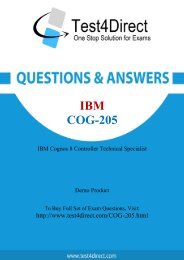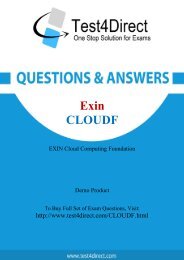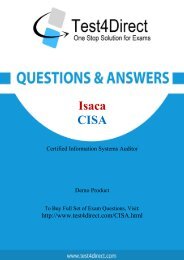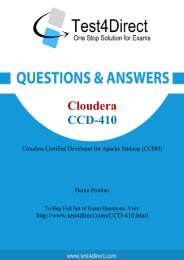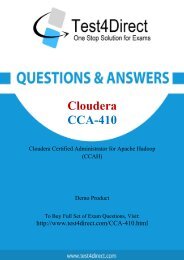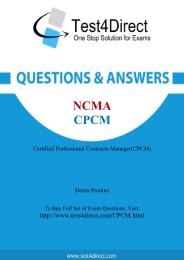C4040-129-demo
You also want an ePaper? Increase the reach of your titles
YUMPU automatically turns print PDFs into web optimized ePapers that Google loves.
IBM<br />
<strong>C4040</strong>-<strong>129</strong><br />
IBM i 7.1 Administration<br />
Demo Product<br />
To Buy Full Set of Exam Questions, Visit:<br />
http://www.test4direct.com/<strong>C4040</strong>-<strong>129</strong>.html
Question: 1<br />
A batch job runs daily in the QBATCH subsystem with a run priority of 50. The job normally takes an<br />
hour to complete and no other batch jobs run during this time. The administrator needs to reduce<br />
the run time and requests the run priority be lowered to 40. However1 after the change, run time<br />
does not decrease. What is the likely reason that the run time did not decrease?<br />
A. The run priority applies to only interactive jobs.<br />
B. D82 Symmetric Multiprocessing has not been installed.<br />
C. The run priority represents only the relative importance of the job.<br />
D. The system value QPFRADJ (Performance Adjustment) is set to “No adjustment.”<br />
Question: 2<br />
Question: 3<br />
Question: 4<br />
Answer: C<br />
Which graphical tool will help identity additional details about activity on the system, to isolate the<br />
root cause of performance problems?<br />
A. PEX<br />
B. iDoctor<br />
C. Performance Monitor<br />
D. Communications Trace<br />
Answer: B<br />
The threshold limit has been reached for the system ASP on a system running IBM i 7.1 . There are<br />
some disk units configured to a user ASP available. Business continuing policy prevents the<br />
administrator from stopping the system. How could the system administrator correct the storage<br />
problem in the system ASP?<br />
A. Increase the ASP threshold above the currently utilized storage.<br />
B. Concurrently remove available disk units from user ASP using the “Remove units from<br />
configuration” SST option and add them to system ASP.<br />
C. Switch to the backup system using an HA solution and restart the original system to DST. Remove<br />
the available disk units from user ASP and add them to system ASP.<br />
D. Initiate a control panel function 21 to activate DST on the system console for the affected<br />
partition. Use the DST feature to compress the parity stripe to increase available storage.<br />
Answer: B<br />
An administrator needs to restore a physical file DATALIB/SMALLFILE from a Save 21 backup of library
DATALIB. DATALIB has several hundred large database files plus other objects. The administrator has<br />
the job log and output from the last full save of DATALIB. What should the administrator do to restore<br />
SMALLFILE in the shortest time?<br />
A. Run the RST command for object “/QSYS.LIB/DATALIB.LIB/SMALLFILE.FILE”<br />
B. Delete SMALLFILE, run RSTLIB specifying *NEW objects, and specify library DATALIB as the starting<br />
library.<br />
C. Run RSTLIB for library DATALIB specifying the position parameter for SMALLFILE in library DATALIB<br />
from the output of the save.<br />
D. Run RSTOBJ for DATALIB/SMALLFILE specifying the position and sequence number for SMALLFILE<br />
in library DATALIB from the output of the save.<br />
Question: 5<br />
What are the key benefits provided by database journaling?<br />
A. Can send updates concurrently to a second system<br />
Can back out incomplete transactions<br />
Can reduce system I/O workload<br />
B. Can reduce application complexity<br />
Can back out incomplete transactions<br />
Can maintain database integrity in the case of an unexpected outage<br />
C. Can send updates concurrently to a second system Can increase performance<br />
Can maintain database integrity in the case of an unexpected outage<br />
D. Can send updates concurrently to a second system<br />
Can back out incomplete transactions and commitment control<br />
Can maintain database integrity in the case of an unexpected outage<br />
Question: 6<br />
Answer: D<br />
Answer: D<br />
Journaling of a large library is running on SYSTEMA and the journal is system managed. Remote<br />
journaling to SYSTEMB has been configured. Due to a communications problem between SYSTEMA<br />
and SYSTEMB, remote journaling is not working and cannot be quickly restarted. Disk utilization on<br />
SYSTEMA is increasing rapidly. To reduce disk utilization the administrator tries to delete journal<br />
receivers on SYSTEM A. Attempts fail and the following message displays:<br />
CPF705F: Receiver not replicated to 1 remote journals.<br />
What must the administrator do to delete journal receivers on SYSTEMA?<br />
A. Delete and recreate only the journal, and then delete the receivers.<br />
B. Stop journaling, as this must be ended first, and then delete the receivers.<br />
C. Use the DLTJRNRCV command and change the delete option parameter to ignore target receivers.<br />
D. Use the CHGJRN command to change the Manage Receivers parameter to allow user<br />
management of journal receivers and then delete the receivers.<br />
Answer: C
Question: 7<br />
Due to an application problem, management has requested the IPL of a partition running IBM i 7.1.<br />
The administrator initiates the IPL, and during the restart phase notices the IPL is running in manual<br />
mode even though the HMC partition settings indicate B NORMAL. Why is the IPL running in manual<br />
mode?<br />
A. The PWRDWNSYS command restart parameter is set to *MANUAL.<br />
B. Manual is the default IPL mode when there is a console problem.<br />
C. The QIPLTYPE system value is set to “Attended IPL, Console in debug mode”.<br />
D. Manual is the default IPL mode when the previous system end indicator is abnormal.<br />
Question: 8<br />
Question: 9<br />
Question: 10<br />
Answer: C<br />
An administrator has been asked to update an IBM i 7.1 system to the most current Technology<br />
Refresh available from IBM. Which method is the most appropriate to achieve the update?<br />
A. Perform a D-mode IPL using the Technology Group PTF package SF99707.<br />
B. Perform a slip install using the most current 1_Base_01 resave media available.<br />
C. Perform a scratch install using the most current 1_Base_01 resave media available.<br />
D. Perform an install of the Technology Group PTF package SF99707 using the GO PTF menu.<br />
Answer: D<br />
A company has just purchased a new POWER7 server running IBM i 7.1 to replace an older system<br />
running V5R4M5. Due to a mistake by a programmer on the V5R4 system, data was accidently<br />
deleted. To recover, the administrator backs up the deleted data to virtual tape on the 7.1 server and<br />
attempts to restore it on the V5R4 server. The restore on the V5R4 server fails with a message stating<br />
the data was saved from a more recent release of the operating system. Which option will solve this<br />
problem?<br />
A. Save the data to physical media.<br />
B. Set the target release parameter to V5R4M0 when saving the data.<br />
C. ETP the virtual tape image catalog from the 7.1 server using binary mode.<br />
D. Use the target release parameter *RECOVER and the access path parameter set to VSR4MO.<br />
Answer: B<br />
A disaster recovery test is being performed, using backups from a production system. The backup<br />
process is as follows:<br />
Full system save, using GO SAVE Option 21, for weekly backup SAVCHGOBJ LIB(*ALL) is used for daily<br />
library backup, in addition to DLO and IFS saves The disaster recovery test is at the point where<br />
libraries are ready to be restored Which pair of actions will restore the libraries to the most recent
save point, in the minimum amount of time?<br />
A. Use RSTLIB(*NONSYS) to restore all libraries and object from the SAVE 21 weekly save. For each<br />
daily tape, run a RSTLIB for each library saved by SAVCHGOBJ.<br />
B. Use RSTLIB(*NONSYS) to restore all libraries and object from the SAVE 21 weekly save. Then run a<br />
RSTOBJ for each library saved by SAVCHGOBJ on the most recent daily tape.<br />
C. Run RSTOBJ for each library saved by SAVCHGOBJ on the most recent daily tape. Then run<br />
RSTLIB(*NONSYS) OPTION(*NEW) to restore the remaining libraries and objects from the SAVE 21<br />
weekly save.<br />
D. For each daily tape, run RSTOBJ for each library saved by SAVCHGOBJ on the daily tapes. Then run<br />
RSTOBJ(*NONSYS) OPTION(*NEW) to restore the remaining libraries and objects from the SAVE 21<br />
weekly save.<br />
Question: 11<br />
Question: 12<br />
Question: 13<br />
Answer: B<br />
An administrator maintains four image catalogs on a host partition that are used by network-based<br />
virtual optical drives. Periodically, images are added or removed from the catalog and it must be reexported.<br />
What is the simplest method to update the share and NES export?<br />
A. Create a CL program.<br />
B. Create a REXX program.<br />
C. Create a Qshell script.<br />
D. Run the statements manually as needed.<br />
Answer: B<br />
Which statement describes server firmware delivery that uses PTF5 on a POWER7 system?<br />
A. A single IBM i (57703S1) PTF is ordered to update server firmware.<br />
B. The firmware is ordered using the marker PTF ID, such as MHxxxxx, and is installed with normal<br />
IBM i PTE commands.<br />
C. The server firmware PTE (MFxxxxx) is ordered from the connected HMC and is sent to the service<br />
partition for install.<br />
D. The HIPER PTF group is ordered for the Licensed Internal Code (5770999) and the order is flagged<br />
with Include Firmware Update *YES.<br />
Answer: A<br />
A Power 720 currently has its firmware update policy set to Os Managed. Which statement is<br />
correct?<br />
A. Server firmware updates will always be disruptive.<br />
B. IPLing from the A side of any partition will activate the new server firmware.
C. Only the Service partition needs PTEs to be installed for the new server firmware to be<br />
immediately activated.<br />
D. Only the Managing partition needs PTF5 to be installed for the new server firmware to be<br />
temporarily activated.<br />
Question: 14<br />
Question: 15<br />
Answer: B<br />
A customer is upgrading an HMC to a new release using Recovery DVD5 for the new release level.<br />
Which action must be completed before performing the upgrade from DVD process?<br />
A. Run the ‘HMC Management> Back Up HMC Data’ to DVD.<br />
B. Run the ‘HMC Management> Save Upgrade Data’ to HMC disk.<br />
C. Run the ‘HMC Management> Back Up HMC Data’ to NFS server.<br />
D. Run the ‘HMC Management> Save Upgrade Data’ to the administrator’s PC.<br />
Answer: B<br />
Several IBM i partitions at a customer site provide outdated contact information to IBM when<br />
problems are reported. Which command should be used to correct the contact information?<br />
A. CHGSVCCFG<br />
B. CHGCNTINF<br />
C. SNDSRVRQS *UPD<br />
D. WRKCNTINE, option 2<br />
Answer: D
THANKS FOR TRYING THE DEMO OF OUR PRODUCT<br />
Visit Our Site to Purchase the Full Set of Actual <strong>C4040</strong>-<strong>129</strong> Exam Questions With Answers.<br />
http://www.test4direct.com/<strong>C4040</strong>-<strong>129</strong>.html<br />
We Also Provide Practice Exam Software That Simulates Real Exam Environment And Has<br />
Many Self-Assessment Features. Download Free Product Demo From:<br />
http://www.test4direct.com/<strong>C4040</strong>-<strong>129</strong>.html<br />
Money Back Guarantee<br />
Check Out Our Customer Testimonials




